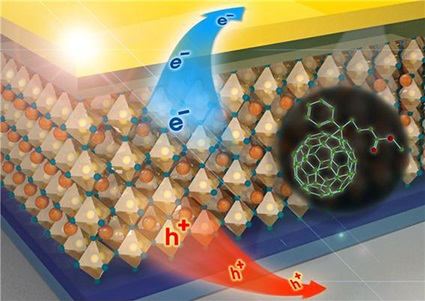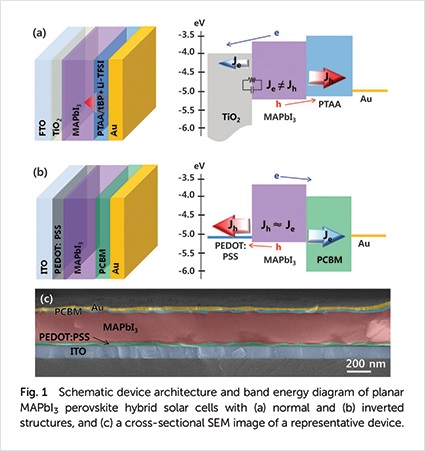06.30.2015
Professor Sanghyuk Im and his research team at the Department of Chemical Engineering have drastically improved efficiency and reliability of perovskite solar cells, poised to breach the threshold of commercialization of the new solar cell technology. The new inverted MAPbI3 planar perovskite hybrid solar cells have demonstrated superior device performance on par with the conventional crystalline silicon at 18.1% average conversion rate while exhibiting no apparent current density-voltage (<J―V) hysteresis with respect to the scan direction and scan rate. The research findings were published on April 1, 2015, in Energy & Environmental Science. Professor Im was the research supervisor, and the authors from Kyung Hee included Jinhyuck Heo (lead author) and Hyeji Han (Department of Chemical Engineering, ’10).

Promising solution to perovskite’s durability problem
Perovskite solar cells are extremely cheap to produce the raw material for and much easier to manufacture, leading to a significant reduction in overall cost by mass production, compared to conventional crystalline silicon solar cells. The downsides of perovskite solar cells, on the other hand, have been low efficiency and poor durability, mainly due to corrosive additives required to improve performance that can damage cells in the long run. Professor Im’s team raised the average efficiency of the hybrid perovskite solar cells to 18.1%, which is roughly on the same level with the conventional silicon cells, and resolved the durability problem by inverting the perovskite structure instead of using corrosive additives. He said, “While trying various methods to rid of the corrosive additives, we settled for the inverted perovskite structure. This gave a promising start to resolving the durability issue, which was considered to be the biggest obstacle to massive-scale commercialization of perovskite solar cell technology.”
New theoretical model for the mechanism of hysteresis
The precise mechanism of hysteresis in perovskite solar cells has not been identified. So far the majority opinion seems to seek the cause in the intrinsic material properties of perovskite arguing that a layer of mesoporous electron conductor such as titanium dioxide (TiO2) is necessary to eliminate the J―Vhysteresis. Adding TiO2, however, requires expensive high-temperature manufacturing processes that dilute the biggest strength of perovskite solar cells: cheap price. Professor Im’s team has instead developed a flat-type inverted perovskite solar cell without TiO2 scaffold that can be manufactured at 150 degree Celsius, which can minimize the production cost.
Professor Im said, “We started the research on perovskite solar cells four to five years ago, but prior to that we had already accumulated with government research funding extensive knowledge and experience on semiconductors, quantum-dot solar cells and photodetectors in preparation for the development of next generation solar cell technology. That experience allowed us to develop a novel solution to the intractable hysteresis problem. We were able to do so mainly because we continually questioned the premise and tried to see for ourselves rather than taking for granted what others had said about the problem. This attitude of persistently challenging the existing premises is what I want to impress on my students.”
Translated by Tae Hun Kim















